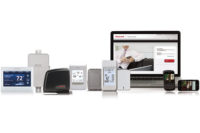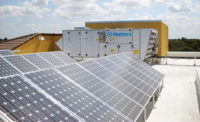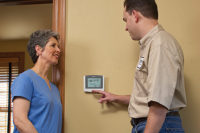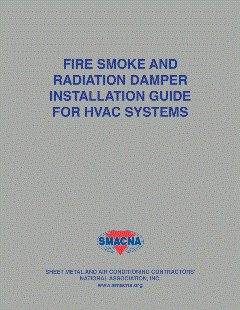Improper ventilation allows pollutants like chemicals, allergens, dust, and mold to build up in a building or home, putting its occupants at risk. Most often, responsibility for properly ventilating these buildings — without bankrupting their customers — ultimately lands in the hands of the HVAC contractor.
Luckily, advances in heat and energy recovery ventilation technology, driven largely by industry standards and increasingly stringent building codes, have pushed manufacturers to offer multiple energy-saving ventilation solutions contractors can choose from for new and retrofit projects on residential and commercial structures.
Fast-Growing Market
The more outside air a building pulls in, the harder the HVAC system will have to work to condition that air. Heat recovery ventilators (HRVs) help mitigate that energy loss by extracting heat from exhaust air and applying it to the incoming fresh air. Similarly, energy recovery ventilators (ERVs) extract both heat and humidity from exhaust air in order to pre-treat fresh air.
“Energy recovery technology comes in different forms,” explained Randy Steele, vice president and general manager, Airxchange Inc. “There’s the cross-flow or plate heat exchanger, there’s heat pipe heat exchangers, and there are rotary heat exchangers. Originally, they were all HRVs, but then rotary came along, and now enthalpy cores allow moisture to transfer through the walls of the heat exchanger.”
Steele added that the payback for ERVs, which can help reduce outdoor air ventilation costs by up to 80 percent, is “anywhere from zero to two years on new construction or replacement work, but, if you add it to a building, it could be anywhere up to five or six years, and the typical lifespan of an ERV is 15 years.”
Both HRVs and ERVs are steadily growing in popularity on both the residential and commercial side. Scott Laurila, product manager, tempered air products, Greenheck Fan Corp., said Greenheck has seen significant growth with ERV products and noted that new construction makes up the bulk of the company’s ERV installations. “The projects are typically larger in scale, which means more opportunity for incorporating energy recovery equipment into the design,” he added.
Ken Nelson, Northwest regional sales manager, Panasonic Eco Solutions North America, said Panasonic has also seen tremendous growth in the ERV market recently, both in new and retrofit situations.
“Our ERV sales have absolutely grown over the last couple of years, and as energy costs continue to rise, we see the ERV market continuing to expand,” Nelson said. “Overall, our ERV sales are relatively balanced with regard to new construction versus retrofit.”
Nelson added that, dollar for dollar, commercial projects often outshine residential ERV installations. However, unit for unit, “the residential market is brisk,” he said.
Pat Nielsen, marketing manager, balanced ventilation systems, Broan-NuTone LLC, said consumers are more interested than ever in finding energy-efficient solutions to help enhance their IAQ.
“Builders and contractors are in tune with this consumer demand for quality indoor air and are better understanding the products they can offer as solutions,” Nielsen said. “That’s exactly what continues to motivate us to give our customers energy-efficient whole-house ventilation solutions.”
Building Code Influence
While residential building codes often do not address or mandate mechanical ventilation, building codes are being adopted state-by-state across the country that mandate energy recovery on the commercial side.
“What’s really driving the scaling of this technology is the national energy codes and ANSI/ASHRAE/IEC Standard 90.1,” Steele said. “I think in 2004, they had some provisions for energy recovery written into 90.1; ASHRAE 90.1-2010 is now being adopted at the state level in building codes. That significantly expands where ERVs are required. For instance, ERVs are going to become mandated in schools.”
Energy codes are currently the biggest driver for the use of energy recovery products, said Laurila. “Guidelines for energy recovery usage outlined in ASHRAE 90.1-2010 are currently being enforced as local jurisdictions adopt IECC 2012. As the IECC 2012 is adopted, several applications and designs where ERVs used to be a nice-to-have feature will soon transition to a required component of the ventilation system.”
While building codes are pushing manufacturers to come out with better products, Nelson said code developers walk a tight line between energy efficiency and affordability. “They can’t implement building codes that make a building so expensive it’s unsellable, but they have a certain responsibility to the home buyer to police unlivable structures,” he said.
The Future of Energy Recovery
With energy recovery soon to be mandated in many states, manufacturers will continue to meet the demand for better, more affordable solutions. “We feel the systems will continue to become more efficient both in terms of cfm per watt and heat and energy recovery,” Nielsen said. “They will also become more compact in size.”
Laurila said efficiency may continue to improve, though “it’s unlikely the effectiveness of the components can be improved much higher than 80 percent from a cost-benefit perspective.” He added that, in addition to the requirements in energy codes, “the market could see a growing requirement for sub-system ratings that ensure the ERV component is designed and installed in an efficient system.”
Nelson said the race is on to develop a product that provides “balanced, filtered, and tempered air — the group that solves this building science triad will be heroes.”
Product Showcase
Energy recovery and heat recovery ventilators are sold separately or as part of new HVAC systems on both the residential and commercial sides. Here are a few of the latest HRV and ERV products.
Airxchange Energy Recovery Wheel
Airxchange energy recovery wheels are purposely designed with innovative materials and maintenance features to ensure optimal performance for the life of the HVAC system. Advanced polymer media reduces wheel weight and depth and will not corrode in harsh environments. An all-stainless wheel provides superior strength and is structurally independent from the energy transfer media for extended wheel life. A unique segmented design allows for easy removal of energy transfer segments for cleaning or replacement. Desiccants applied to the polymer surface transfer moisture and are permanently bonded without adhesives. Segments may be washed repeatedly without compromising desiccant performance. Airxchange wheels are available from most HVAC equipment manufacturers in stand-alone energy recovery ventilators, air handlers, packaged rooftop units, or add-on accessories.
“Airxchange offers both heat recovery ventilators and energy recovery ventilators; they’re all rotary and range in size from 70 cfm up to 35,000 cfm, from residential on up to large commercial applications. We also went ahead and made sections of the wheels that can be taken out without tools and soaked overnight.” — Randy Steele, vice president and general manager, Airxchange Inc.
Broan HRV150TE
The Broan HRV150TE is an efficient and environmentally friendly heat recovery ventilator. Its innovative design incorporates extremely high-performance ECM motors, which enable it to operate on power equivalent to a compact fluorescent bulb (13.5 W), significantly lowering energy costs. Additional energy efficiency is found through its advanced heat recovery core, which can retain up to 80 percent of a home’s heating. It surpasses energy-saving standards while providing effective heat recovery, ventilation, and quiet operation. All aspects have been designed to facilitate balancing of airflow and simplify use and installation.
“We’ve been manufacturing Balanced Ventilation Systems for years, before IAQ was given as much attention as it is today. Some of our newest models of HRVs/ERVs, introduced in late 2013, are equipped with HEPA filters that remove 99.97 percent of allergens and other microscopic particles in the air, making the systems ideal for homes with children and families where clean air is essential.” — Pat Nielsen, marketing manager, balanced ventilation systems, Broan-NuTone LLC
Daikin Applied Energy Recovery Wheel Option for Rebel
Daikin Applied’s Rebel with energy recovery wheel exceeds ASHRAE Standard 90.1 requirements for energy recovery. The Energy Recovery Wheel option for Rebel recovers approximately 75 percent of energy from the exhaust airstream. As the wheel rotates, outside air is drawn across half of the wheel while exhaust air is drawn across the other half, transferring sensible and latent energy between the ventilation and exhaust airstreams. Free heat and humidity are recovered during winter months, while free cooling and dehumidification occurs during the summer months. Easy, slide-out accessibility to the wheel is provided, simplifying service and cleaning for long-term, efficient wheel operation.
“We are continuing to develop products that advance energy efficiency and provide optimal comfort. Adding an energy recovery wheel to the Rebel helps the end user by providing additional energy savings in all seasons.” — Skip Ernst, marketing manager, Daikin Applied
Greenheck Model ERV
The Greenheck Model ERV incorporates innovative design features with varying levels of configurable options and energy wheel performances to provide a quality constructed unit with operational flexibility. The result is a product that will fit seamlessly into ventilation system designs to improve IAQ while reducing energy costs.
“The Model ERV is an efficient approach to reducing the high costs associated with conditioning outdoor air.” — Scott Laurila, product manager, tempered air products, Greenheck Fan Corp.
Modine Airedale ClassMate with Energy Recovery Wheel
Modine’s new Airedale ClassMate has been redesigned, thanks to the addition of the CF coil. By moving to this groundbreaking coil — in lieu of traditional round-tube plate fin coils — more space became available inside the unit, compared to the previous model. This additional space gives schools multiple energy-saving options when it comes to their IAQ. The energy recovery wheel allows up to 500 cfm and has its own dedicated, fully modulating ECM fans, which, when combined with the Modine Controls System, guarantees optimal performance and ventilation rates. If schools are looking for more options for bringing in outside air, they can also add an economizer alongside the ERV to bring in air when conditions are optimal.
“Schools have to find a way to meet IAQ regulations. They want to do this as efficiently, and quietly, as possible. The ClassMate does both, thanks to its multiple airflow configurations and our new CF coil, which increases EER up to 12 percent over previous models with integrated part-load values over 16. Our ERV comes with dedicated blowers as well, ensuring more airflow and energy control.” — Richard Boothman, North American sales director, Modine Mfg. Co.
Panasonic WhisperComfort
The Panasonic WhisperComfort Spot ERV offers a revolutionary way to provide balanced ventilation. Affordable and easy to install, WhisperComfort is energy efficient and provides fresh ventilated air while maintaining IAQ. It features spot-balanced ventilation and low-rate continuous run, which is ideal for multifamily dwellings. Panasonic WhisperComfort Spot ERV uses two 4-inch ducts — one to exhaust stale air and the other to supply fresh air from outdoors. Its low, continuous run ensures volatile organic compounds (VOCs) are vented out and replaced with fresh air. WhisperComfort does not require connection to the central HVAC or the addition of a condensation line. This Spot ERV feature allows it to be installed in many places throughout the home to meet comfort, health, and IAQ needs.
“At Panasonic, we’re fortunate that our spot ERV is very easy to install. Many of the larger, more complex applications are difficult to use in retrofit applications. Given how easy it is to install, we’ve seen strong retrofit sales.” — Ken Nelson, Northwest regional sales manager, Panasonic Eco Solutions North America
Trane Performance Climate Changer
The Performance Climate Changer air handlers from Trane, a brand of Ingersoll Rand, optimize energy conservation and deliver efficiency to the entire HVAC system. Unit features are designed to surpass ASHRAE 90.1 standards and provide the flexibility to tailor air handler selection to specific application requirements while staying within customers’ budgets.
Additional options, like Air-Conditioning, Heating, and Refrigeration Institute (AHRI) 1060-certified energy wheels, a Dual Exhaust Energy Recovery (DEER) system, and air-to-plate heat exchangers, increase savings by providing advanced energy recovery capabilities. Available Traq™ dampers also reduce costs by enabling a more efficient demand control ventilation strategy.
“Performance Climate Changer air handlers combine the Trane tradition of engineering excellence with advanced manufacturing technology to deliver superior performance, quality, and reliability. With the Performance Climate Changer there is no need to compromise. You can get lower utility bills and better IAQ, too.” — Rolf Paeper, Trane Airside portfolio leader, Trane, a brand of Ingersoll Rand
Publication date: 4/21/2014

















